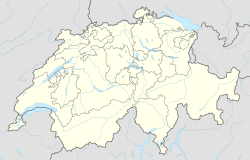
Urnäsch is a municipality in the canton of Appenzell Ausserrhoden, Switzerland.

Herisau is a municipality and the capital of the canton of Appenzell Ausserrhoden in Switzerland. It is the seat of the canton's government and parliament; the judicial authorities are situated in Trogen.

Schwellbrunn is a municipality in the canton of Appenzell Ausserrhoden in Switzerland.

Hundwil is a municipality in the canton of Appenzell Ausserrhoden in Switzerland.
Stein is a municipality in the canton of Appenzell Ausserrhoden in Switzerland.

Teufen is a municipality in the canton of Appenzell Ausserrhoden in Switzerland.

Speicher is a municipality in the canton of Appenzell Ausserrhoden, in Switzerland.

Trogen is a municipality in the canton of Appenzell Ausserrhoden in Switzerland. The town is the seat of the canton's judicial authorities.

Grub AR is a municipality in the canton of Appenzell Ausserrhoden in Switzerland.

Heiden is a village and a municipality in the canton of Appenzell Ausserrhoden in Switzerland. Its Biedermeier village around the church square is listed as a heritage site of national significance.

Wolfhalden is a municipality in the canton of Appenzell Ausserrhoden in Switzerland.

Lutzenberg is a municipality in the canton of Appenzell Ausserrhoden in Switzerland. Its hamlet of Tobel is listed as a heritage site of national significance.

Walzenhausen is a municipality in the canton of Appenzell Ausserrhoden in Switzerland.
Stein am Rhein is a historic town and a municipality in the canton of Schaffhausen in Switzerland.

Gossau is a municipality in the Wahlkreis (constituency) of St. Gallen in the canton of St. Gallen in Switzerland.

Guarda is a former municipality in Inn District in the Swiss canton of Graubünden. On 1 January 2015 the former municipalities of Ardez, Guarda, Tarasp, Ftan and Sent merged into the municipality of Scuol.

Grüningen is a town and municipality in the district of Hinwil in the canton of Zürich in Switzerland, notable for its well-preserved historic nucleus.

Hombrechtikon is a municipality in the district of Meilen in the canton of Zürich in Switzerland.

Splügen is a former municipality in the Viamala Region in the Swiss canton of Graubünden. On 1 January 2006 Splügen incorporated its neighbouring municipality of Medels im Rheinwald. On 1 January 2019 the former municipalities of Hinterrhein, Nufenen and Splügen merged to form the new municipality of Rheinwald.

Vrin is a village and a former municipality in the Lumnezia. It belonged to the circle of Lugnez/Lumnezia in the district of Surselva in the canton of Graubünden in Switzerland. The municipalities of Cumbel, Degen, Lumbrein, Morissen, Suraua, Vignogn, Vella, and Vrin merged on 1 January 2013 into the new municipality of Lumnezia.


























